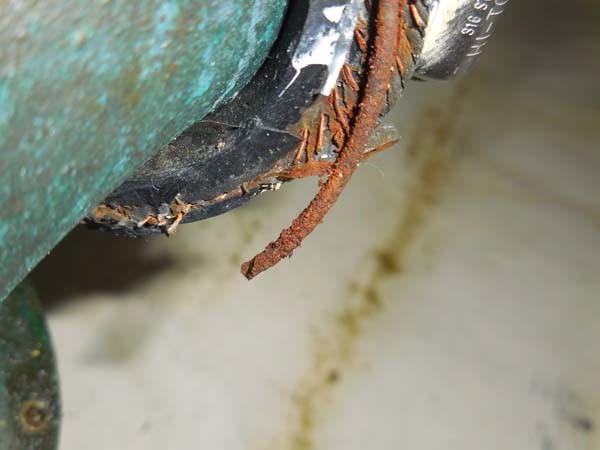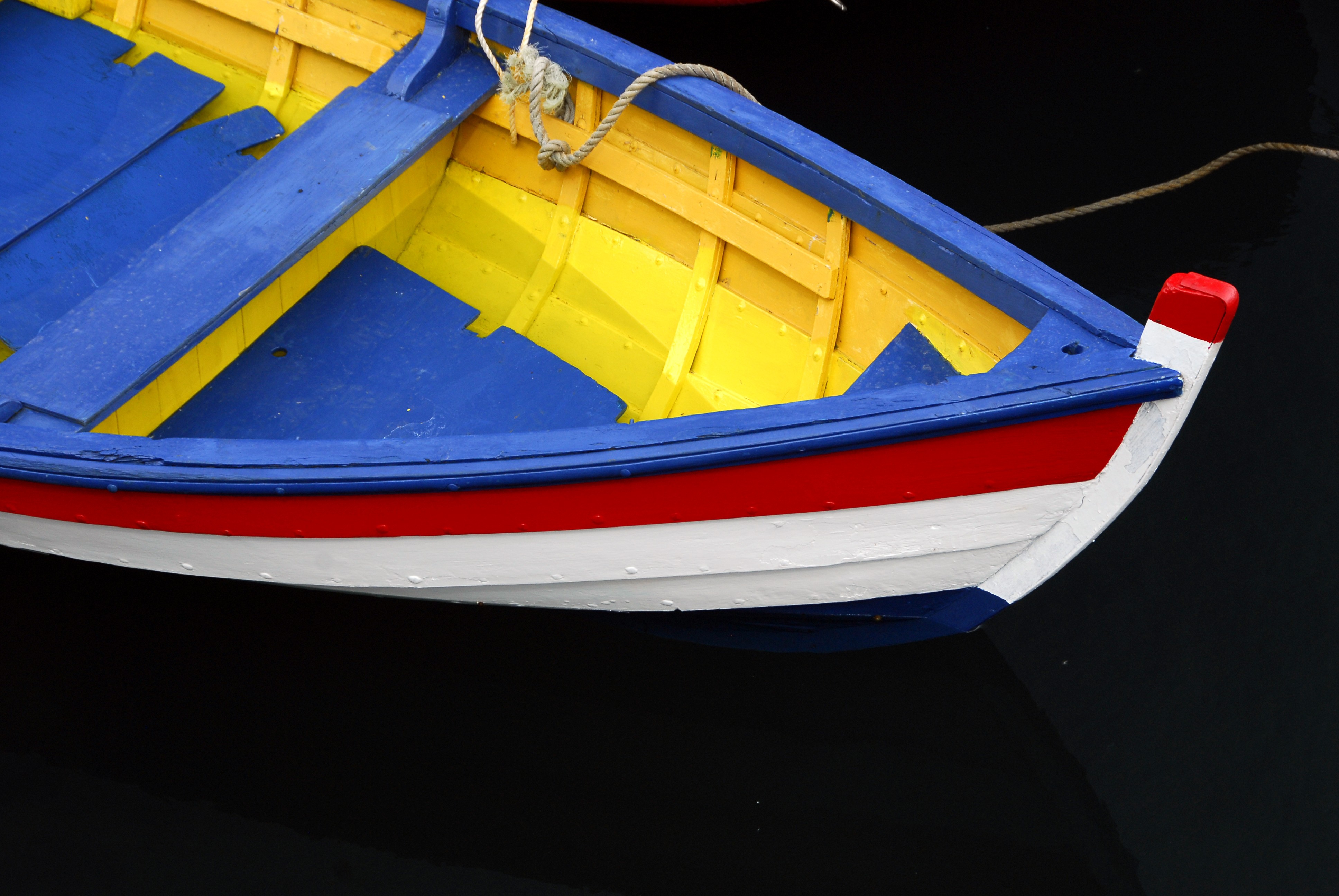Text and photos copyright © SDMC, Inc. 2016
Photo Essay

While it may be cliché, the first words that come to mind when I see this image are, “An accident waiting to happen”. As someone who spends a considerable amount of time crawling around engine rooms, through bilges and in engineering spaces, I’m acutely sensitive to laceration and injury hazards. I’ve given more than my fair share of blood thanks to errant hose clamps, cut-off wire ties and exposed fasteners. Generally speaking hose clamps are the worst offender, perhaps because there are so many of them aboard every boat. You can improve their safety record by making sure the correct length is used, avoiding the ubiquitous, scythe-like “tail” that protrudes from so many of them. Even when the length is correct, they remain a hazard which can be further mitigated with two approaches. First, using a needle nose pliers bend the bitter end down so it’s pressing against the tensioned portion of the clamp. Second, install hose finishers, I prefer the silicone rather than PVC variety, they are stickier and less likely to fall off. This treatment of hose clamps is especially important in high hand traffic areas, on and around engines, near all seacocks and valves and under sinks.
Wire ties can be rendered safe by using a proprietary “flush cut” wire tie cutting tool. See this Facebook post for details.
In the case shown here, the exposed, rusty hose reinforcing wire should be cleanly cut off as close to the hose as possible. In cases where it’s impossible to cut this off flush, applying a dab of silicone or polyurethane sealant over the remaining exposed wire will cover the sharp edge.
Finally, onboard lacerations are fertile ground for infections and worse. Every boat owner and crewmember should, therefore, make certain his or her tetanus vaccination is up to date. After your childhood series, a booster is required every 10 years.
Ask Steve
Comments/ Questions from Marine Systems Excellence eMagazine article on under loading: https://stevedmarineconsulting.com/the-perils-of-chronic-under-loading/
Steve,
Another excellent and useful piece. I’ve been working on fuel efficiency for commercial fishing vessels and in one project we did vessel energy audits and had a marine engineer to take data on, among other things, actual hp output on fishing vessels in use. We found that nearly all were running at 30% rated output or less. The irony is that many fishermen now are under-loading their engines in response to what they have learned about saving fuel by throttling back. But to most fishermen, bigger is better, and as you say in your article, there’s a persistent belief that under-loaded engines last longer. We found genset under-loading just a prevalent.
My current concern is direct seawater cooled engines, many of which are still being used in sailboats. The concern used to be saltwater corrosion but apparently manufacturers have been able to pretty much prevent that with proper interior coatings and zincs. But they use cooler thermostats to prevent mineral buildup in cooling passages. I understand that coolant temp and oil temp may be very different, but I wonder if dsw cooling leads to the same engine damage as under-loading.
Regards,
Terry L. Johnson
Professor of Fisheries, Marine Advisory Agent
Alaska Sea Grant Marine Advisory Program
School of Fisheries and Ocean Sciences
Terry:
Your concerns regarding direct seawater cooled engines is very valid. I excluded them from my discussion because direct seawater cooled diesel engines are pretty rare these days, I occasionally encounter them in sail auxiliaries (it’s strictly a cost-saving measure, there is no advantage, and many disadvantages, to direct raw water cooling). They are still widespread for gasoline engines. Typically, their thermostats open at 155°F to prevent salt and other minerals from precipiting inside cooling passages, which occurs more readily at higher temperatures.
Steve,
Just read your article on under loading. We have an Azimut 46 planing hull and do a lot of local cruising at slower speeds. I read somewhere that if this is the case and we don’t want to underload the engines we should run one engine at a higher rpm and keep the other one off.
A couple of questions;
- Is this a common practice?
- If so, should the prop be locked or set in reverse to avoid free wheeling?
- We have Cat 3208’s with MPM IRM 280A marine gears.
Thanks,
Dan Woodworth
Dan:
Periodically running your engines up to higher load is desirable practice, as noted in the article. However, while not common, you could operate on one engine to more appropriately load it, as well as minimizing wear and tear and maintenance costs, while “trailing” the other engine.
Locking shafts is challenging, because your transmissions are hydraulic they will not lock when placed in reverse. You would need a substantial, custom-made locking fixture to do this. Having said that, most transmission manufacturers provide instructions for freewheeling operation, allowing the shaft to turn, which would be used if the vessel were towed for instance, and the boat builder and/or stuffing box manufacturer should provide instructions for lubrication of this component as well. Dripless stuffing boxes require injected water lubrication, which can, with some important caveats, be achieved using cross over plumbing.
Steve,
1) Peak combustion pressure in a diesel can be 200 atmospheres; is the 20 in your article a typo?
2) I know that “glazing” isn’t a glaze, it is wear. What causes the rapid wear during light loading?
Thanks,
Erik Vaaler
Erik:
No it’s not a typo. I was referring to the pressure induced solely by compression, which could have been clearer. Indeed you are correct, once ignition begins the pressure is of course much higher.
Glazing refers to the appearance, which is smooth, and shiny, ice-like, however, a coating or “filler” of sorts does form. The actual process is somewhat complex, and it’s broken down into two sub-groups, glazing and polishing. In the former, combustion byproducts, as well and oil and fuel, combine and oxidize to fill in the valleys between or grooves in the cross hatch pattern, creating the smooth finish. The effect is usually uniform and it sometimes has a yellowish appearance.
In the latter, carbon deposits on the rings and piston ring lands prevent the rings from floating, and self-adjusting during piston movement, as well as inhibiting expansion and contraction during heating cycles. This leads to excessive and uneven pressure being placed against the cylinder wall by the seized ring, which leads to wear (as opposed to the deposits in the case of glazing). The effect is often localized vertically on one region of the cylinder wall.
The terms are often used interchangeably, and I confess I’m guilty of this, strictly speaking, however, they are different.
Both can be and often are the result of extended light load operation.
Dear Steve,
Thanks for your GREAT article.
One question: How do I figure out what 75% of Output Capacity for my Universal M50 B engine?
Many thanks,
Jay Peters
Jay:
The determination need not be exact, 75% is a somewhat arbitrary indicator and simply ensures the engine is heavily loaded, so don’t worry too much about getting it exactly right. Many engine manufacturers include charts that will provide a graph showing rpm, from which you can interpolate load. If this isn’t available, or if your engine doesn’t include a load gauge, you can roughly determine this by calculating 75% of the maximum rated rpm of the engine, plus the idle rpm. For example, 75% of 3,000 rpm is 2250, to which you would then add, for example, 600, for 2850. For this engine, anything between 2600 and 2800 would be fine for loading purposes.
NOTE: Two gimlet-eyed readers caught an error in one of the photos used in this article. The photo of the turbo charger was in fact the compressor wheel, the side that compresses fresh air that’s sent to the engine for combustion, as opposed to the turbine wheel, which is actuated by, and lives in, the exhaust gas stream. A photo of the latter was supposed to have been used; it’s now replaced the original incorrect image.



